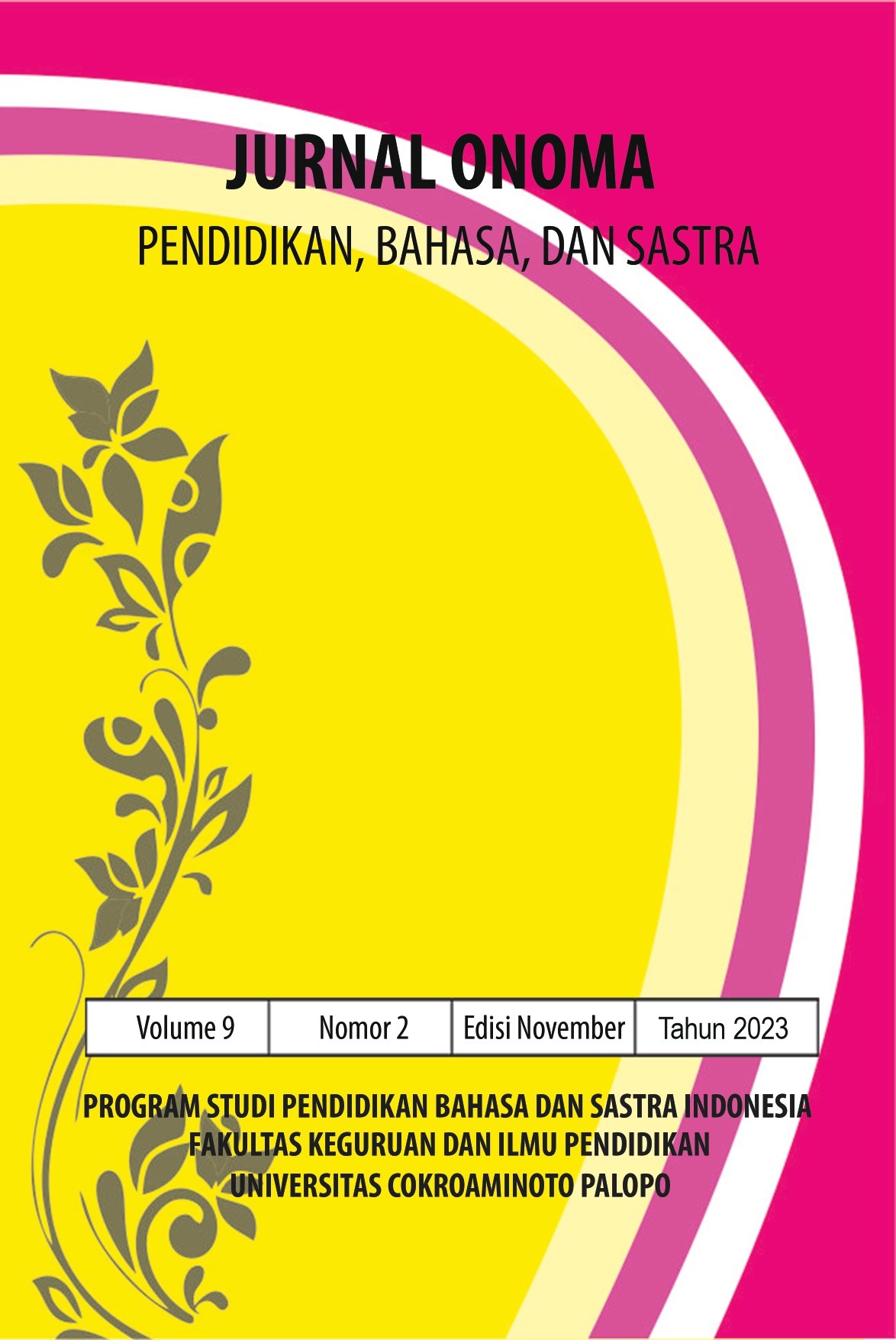Analisis Semiotika Roland Barthes dan Nilai Moral dalam Film Pendek Tilik 2018 Karya Wahyu Agung Prasetya
https://doi.org/10.30605/onoma.v9i2.3023
Keywords:
Kata Kunci: Roland Barthes, Film, Nilai MoralAbstract
Penelitian ini bertujuan untuk mengetahui bentuk-bentuk pemaknaan berdasarkan leksis semiotika menurut Roland Barthes menggunakan kode-kode Roland Barthes, selain penggunaan kode-kode untuk mengungkap makna dalam film tersebut peneliti menganalisis pesan moral dalam film Tilik 2018. Penelitian ini menggunakan pendekatan kualitatif dengan teknik pengumpulan data simak dan catat. Melalui tokoh dalam film Tilik 2018 diungkapkan kehidupan masyarakat yang sesungguhnya, bukan hanya permasalahan sosial tetapi bentuk nilai moral dalam kehidupan bermasyarakat. Hasil analisis yang dilakukan oleh peneliti dengan menggunakan teori semiotika Roland Barthes dalam film Tilik 2018 meliputi; (1) kode hermeneutik, (2) kode semik (3) kode simbolik (4) kode proaretik (5) kode kultural. Pesan moral film Tilik 2018 ini mungkin menggarisbawahi pentingnya memegang teguh nilai-nilai etika dalam interaksi sosial. Sikap positif dan menghindari pencemaran nama baik adalah contoh bagaimana etika dapat membentuk perilaku dan hubungan sosial. Budaya menjenguk orang sakit di Indonesia adalah contoh yang baik dari bagaimana nilai-nilai moral, social dan budaya membentuk perilaku dan interaksi manusia. Ini mencerminkan komitmen kuat terhadap kemanusiaan dan perhatian terhadap kesejahteraan sesama anggota masyarakat.
Downloads
References
Kanzunnudin, Mohammad. 2022. “ANALISIS SEMIOTIK ROLAND BARTHES PADA PUISI ‘IBU’ KARYA D. ZAWAWI IMRON (Semiotic Analysis of Roland Barthes at ‘Ibu’ Poetry by D. Zawawi Imron).” Sawerigading 28(2). doi: 10.26499/sawer.v28i2.1040.
Manesah, Dani, Rosta Minawati, and Nursyirwan Nursyirwan. 2018. “Analisis Pesan Moral Dalam Film Jangan Baca Pancasila Karya Rafdi Akbar.” PROPORSI : Jurnal Desain, Multimedia Dan Industri Kreatif 3(2):176–87. doi: 10.22303/proporsi.3.2.2018.176-187.
Nasirin, Choiron, and Dyah Pithaloka. 2022. “Analisis Semiotika Konsep Kekerasan Dalam Film The Raid 2 : Berandal.” Journal of Discourse and Media Research 1(1):28–43.
Nisa, Chairun, and Roita Sinaga. 2023. “Analisis Semiotika Roland Barthes Terhadap Nilai Nasionalisme Dalam Novel Titik Nadir Karya Windy Joana 1.” Jurnal Pendidikan, Bahasa, Sastra, Seni, Dan Budaya 3:4–8.
Noviardi Fadilatul Rahman, and Anisa Fitriyani. 2022. “Nilai Kehidupan Pada Puisi ‘Derai – Derai Cemara’ Karya Chairil Anwar.” Protasis: Jurnal Bahasa, Sastra, Budaya, Dan Pengajarannya 1(1):92–97. doi: 10.55606/protasis.v1i1.29.
Nur Hanifah, Annisa, and Rivga Agusta. 2021. “REPRESENTASI PEREMPUAN DALAM FILM PENDEK ‘TILIK’ (Representation of Women in Short Movie Titled ‘Tilik’).” Jurnal Semiotika 15(2):2579–8146.
Tirtamenda, Aditya Ramadhani. 2021. “Permainan Bahasa Dan Analisis Semiotika Pada Dialog Film Pendek ‘Tilik.’” LUGAS Jurnal Komunikasi 5(1):1–9. doi: 10.31334/lugas.v5i1.1551.
Vidiyah, Nurul. 2022. “Semiotik Roland Barthes Dalam Film Animasi Entong Sebagai Implikasi Penerapan Bahan Ajar Sastra Di Sekolah Dasar.” Jurnal Perseda : Jurnal Pendidikan Guru Sekolah Dasar 4(3):187–95. doi: 10.37150/perseda.v4i3.1472.
Weisarkurnai, Bagus Fahmi. 2017. “Representasi Pesan Moral Dalam Film Rudy Habibie Karya Hanung Bramantyo (Analisis Semiotika Roland Barthes).” Jom Fisip 4(1):1–14.
Wibisono, Panji, and Yunita Sari. 2021. “Analisis Semiotika Roland Barthes Dalam Film Bintang Ketjil Karya Wim Umboh Dan Misbach Yusa Bira.” Jurnal Dinamika Ilmu Komunikasi 1(1):30–43.
Downloads
Published
How to Cite
License
In submitting the manuscript to the journal, the authors certify that:
- They are authorized by their co-authors to enter into these arrangements.
- The work described has not been formally published before, except in the form of an abstract or as part of a published lecture, review, thesis, or overlay journal.
- That it is not under consideration for publication elsewhere,
- That its publication has been approved by all the author(s) and by the responsible authorities – tacitly or explicitly – of the institutes where the work has been carried out.
- They secure the right to reproduce any material that has already been published or copyrighted elsewhere.
- They agree to the following license and copyright agreement.
License and Copyright Agreement
Authors who publish with Onoma Journal: Education, Languages??, and Literature agree to the following terms:
- Authors retain copyright and grant the journal right of first publication with the work simultaneously licensed under Creative Commons Attribution License (CC BY 4.0) that allows others to share the work with an acknowledgment of the work's authorship and initial publication in this journal.
- Authors are able to enter into separate, additional contractual arrangements for the non-exclusive distribution of the journal's published version of the work (e.g., post it to an institutional repository or publish it in a book), with an acknowledgment of its initial publication in this journal.
- Authors are permitted and encouraged to post their work online (e.g., in institutional repositories or on their website) prior to and during the submission process, as it can lead to productive exchanges, as well as earlier and greater citation of published work.

















